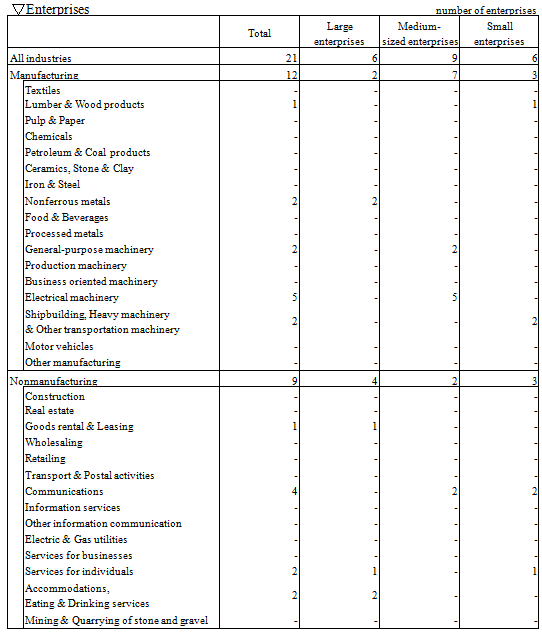Addition of Sample Enterprises to the Tankan
February 24, 2014
Bank of Japan
Research and Statistics Department
The Bank of Japan has decided that, from the March 2014 Tankan (Short-Term Economic Survey of Enterprises in Japan), 21 enterprises will be added to the sample of the survey, and the total number of sample enterprises will be 10,483.
The statistical accuracy of the Tankan is examined once a year, to spot a possible decline in the statistical accuracy due to a decrease in the number of the sample caused by bankruptcies, mergers, and other factors. New sample enterprises and financial institutions have to be added to the Tankan when the examination reveals that statistical accuracy has declined (see "Sample Design and Sample Maintenance of TANKAN," June 7, 2004, for details).
The Bank of Japan has decided to add 21 enterprises to the Tankan (see the Appendix) after the recent examination of the statistical accuracy of the latest Tankan (December 2013). As a result, the total number of sample enterprises and financial institutions for the March 2014 Tankan will be 10,483 and 193 respectively.
Details of the examination are as follows.
1. Sample Distribution
Population enterprises are classified into 397 strata by industry, scale based on capital size, and number of regular employees to calculate the population estimates.
For each stratum subject to the sample design1, whether the distribution of the sample enterprises properly reflected that of the population enterprises was examined. The result showed that there was no stratum in which the distribution of the sample deviated from that of the population2. However, there were some strata for which the sample distribution indicated a high likelihood of deviation from the distribution of the population with a further decline in the number of sample enterprises. To prevent a possible decline in the statistical accuracy, sample enterprises will be added to these strata.
- Strata with less than five enterprises (49 strata) have been excluded.
- The "test of the goodness of fit" using chi-square distribution is used in the regular examination. This method tests the null hypothesis, H0: "The distribution of the sample and that of the population have the same shape." When the hypothesis is statistically rejected, it is judged that a deviation exists between the distribution of the sample enterprises and that of the population enterprises.
2. Error Ratios of the Population Estimates
For all six main divisions by industry and scale (manufacturing/nonmanufacturing and large/medium-sized/small, see below), the error ratios of the population estimates3 measured by sales data remained within the target range of 3 percent for manufacturing and 5 percent for nonmanufacturing after the addition of 21 sample enterprises.
- 3Population estimates based on sample surveys, such as those in the Tankan, inevitably entail certain estimation errors.
Error ratios measured by sales data after the addition of 21 sample enterprises
| Large enterprises | Medium-sized enterprises | Small enterprises | ||
|---|---|---|---|---|
| Manufacturing | Actual | 1.9 | 2.7 | 2.5 |
| Target | 3.0 | 3.0 | 3.0 | |
| Nonmanufacturing | Actual | 3.3 | 4.4 | 4.1 |
| Target | 5.0 | 5.0 | 5.0 | |
Inquiries
Business Survey, Research and Statistics Department
E-mail : post.rsd5@boj.or.jp


